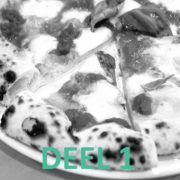Will the rise of agile organisations cause the fall of pyramids?
We are in a paradigm shift. Various influencers and trend watchers have been saying for years that we are in a transition of age, and we are more and more clearly beginning to see the impact on organisations. In this transition from the industrial to the digital age, pyramid organisations are turning into pancake organisations; at least according to Josephine Green in her speech Going Beyond Hierarchy. Pancakes are aimed at customisation, decentralisation, empowerment, distribution of complexity, abundance, collaboration and inclusion. This results in flexible and innovative forms of collaboration and organization.
I prefer calling them pizza organisations. They have the same features as pancakes, but are divided into various elements, or better: slices. We will see a growing need for experts due to the increasing pace of change and complexity of an organisation and its environment. The various pizza slices represent the various types of expertise required to carry out a project, task or assignment. Together, all pizza slices form a (temporary) organisation, team or community. Depending on specific needs pizza slices can easily be moved from one plate to another. After completion of the assignment, some pizza slices remain on the plate and are supplemented with new ‘flavours’ (specialisations).
Social media as a catalyst to change organisations
Social media place a virtual layer over the existing ‘pegs and squares’ and change our way of communicating, collaborating and organising. Not straightaway, but gradually. Ultimately, organisations become flatter (less hierarchical), more agile (shorter and faster responsiveness) and more transparent (more authentic and informative). In addition, because employees are constantly connected with each other and the outside world, boundaries become blurred: between positions, teams, departments and business units within organisations as well as between organisations themselves. Deploying employees according to their expertise and having them collaborate in flexible hubs and ad hoc organisations becomes easier. The pyramid structure will increasingly fade into the background if these flexible ways of organising ultimately become the preferred way of working.
Impact on the organisation
Because of this flattening of structures and blurring of boundaries, we also see a shift from central control to decentralised control and in the case of self-managing teams even to invisible control: responsibility and authority are placed exactly where there is a need for a fast and adequate response. This requires a culture based on trust instead of control. For a large number of managers, this means that their position becomes redundant and for the remaining managers it means that they will have to manage in a different way than they are used to. More emphasis will be placed on facilitating, coordinating, coaching and inspiring. At the same time they need to take into account the personality and drivers of the various types of employees. A clear vision and inspiring, strong leadership creates a sense of purpose and commitment to the organisation. At the same time an holistic view or frame of reference leads to coherence and synergy between the ‘individual’ elements.
Hierarchical leadership becomes less and less relevant. Depending on the context (assignment, project, environment, timing) a different employee – best fit to do the job in that particular context – takes the lead: contextual leadership. Formal and hierarchical lines of communication and escalation become more personal, more informal and more direct. Exclusion and inequality (due to hierarchy, position and status) make way for inclusion and equality. Instead of fixed targets, forecasts and tight (rigid) planning, flat organisations use a (moving) target or focus on different horizons and adjust this to the practical situation and real-time available data as they go along. Instead of making efforts to standardise complexity (bureaucracy), efforts are focused on streamlining and simplifying processes distributing complexity and decentralising it.
| Pyramid | Pizza | |
| Structure | Pegs and squares | Agile and flat |
| Teams | Positions & departments | Roles & flexible hubs |
| Leadership | Hierarchical leadership | Contextual leadership |
| Culture | Control | Trust |
| Power distance | Inequality, Exclusion | Equality, Inclusion |
| Complexity | Standardisation of complexity | Decentralisation of complexity |
| Coordination | Central | Decentralised or invisible |
| Communication | One-way communication | Multi-way communication |
| Branding | Employer branding | Employee experience |
| Touchpoints | Singular, formal, contact | Plural, informal, connection |
| Focus | Organisation-centred | Individual/community-centred |
| Cohesion | Fragmented | Interdependent |
| Environment | Internal & external | Internal = External |
| Planning & Time | Snapshots, planning | Real time, adjusting as you go |
| Targets | Fixed targets | Moving targets, different horizons |
Impact on HR themes
Naturally, the change from pyramid to pizza organisations and the impact of the use of social media also affect HR policy (e.g. the shift from positions to roles and the associated impact on performance reviews, salary scales and remuneration policy) and HR themes, such as labour market communication, internal communication & engagement, personal development, flexibility and change management.
- LABOUR MARKET COMMUNICATION
Personal, multiple relations between employees and prospective candidates provide an easy accessible look behind the scenes of the organisation and information about the added value when joining the company. The candidate experience is the key element in this respect. At the same time, focus increases on raising visibility as an attractive employer in the jumble of messages. Employer Branding (the employer defines and positions the brand) changes according to employee experience (the brand is determined and promoted by the employees’ experiences).
- INTERNAL COMMUNICATION AND ENGAGEMENT
Relevant information spreads smoothly throughout the organisation via internal social media, giving employees easier access to required information and a better view of the bigger picture (context savviness). They feel more involved as a result. The focus shifts from organisations trying to retain employees (organization needs are leading) to employees engaging & committing (employees and their personal drivers are leading): employees connect with like-minded people and at the same time they feel committed to the organisation and its purpose.
- PERSONAL AND PROFESSIONAL DEVELOPMENT
The employee assumes more and more ownership where it concerns personal development. New digital applications make it possible to learn implicitly, informally, continuously and everywhere, in addition to the traditional knowledge transfer in the virtual or physical classroom. Overall organisational objectives and strategic staff planning determine what needs to be learned and developed; the employees decide when, where and how this is to be done.
- FLEXIBILITY
Because an increasing number of processes and activities is being digitised, it is also becoming easier to match the supply and demand of manpower, knowledge and skills. For the deployment of flexible workers, the shift from pyramid to pizza organisations means that they do not necessarily need to be deployed as a flexible layer, but could also be deployed as a flexible core, especially in areas where knowledge is subject to a fast ‘devaluation’. Digital applications have made the matching process and the associated communication more accessible and easier, and provide an environment to stay in touch and connect with each other.
- CHANGE MANAGEMENT
In pizza organisations, changes are initiated by the employees. They have access to relevant information (meaning they have a view of the bigger picture) and at the same time they see what goes wrong (or right) or could be done better in their day-to-day activities. Adjustment takes place in small steps and in a continuous and decentralised manner. This means that large change management processes or reorganizations can be avoided. If necessary anyway, employees or their (union) representations will be involved at an early stage, they will have a bigger say and the wisdom of the crowd will be used more.
| Pyramid | Pizza | |
| Role of HR | Staff position, reactive, implementer | Integral part, proactive, facilitator |
| Labour marketcommunication | Profiling & Positioning, Post & Pray |
Experience, Personalise & Participate |
| Engagement | Retain | Engage & Commit |
| Development | Explicit, knowledge transfer, scheduled |
Implicit, experienced, continuous |
| Flexibility | Flexible layer | Flexible core |
| Change management | Initiative and ownership with management | Initiative and ownership with employees |
Will all organisations become pizzas?
That remains to be seen. We see start-ups who structure themselves in a flat and flexible ‘pizza-like’ manner, even when they grow (although the pitfall of bureaucracy is always lurking). Existing pyramid organisations are having a rougher time. Small organisations are able to make the switch, but large organisations are struggling, simply because it takes time and effort to change. They are working with a number of flexible hubs to accelerate innovation and change, while the rest of the organisation maintains a traditional structure. Some also have trouble letting go of the ‘old ways’ or do not recognise the need for a drastically change. The question that must be asked is whether old structures will adapt quickly enough to be able to survive. One thing is for certain: not taking any action is not an option!






